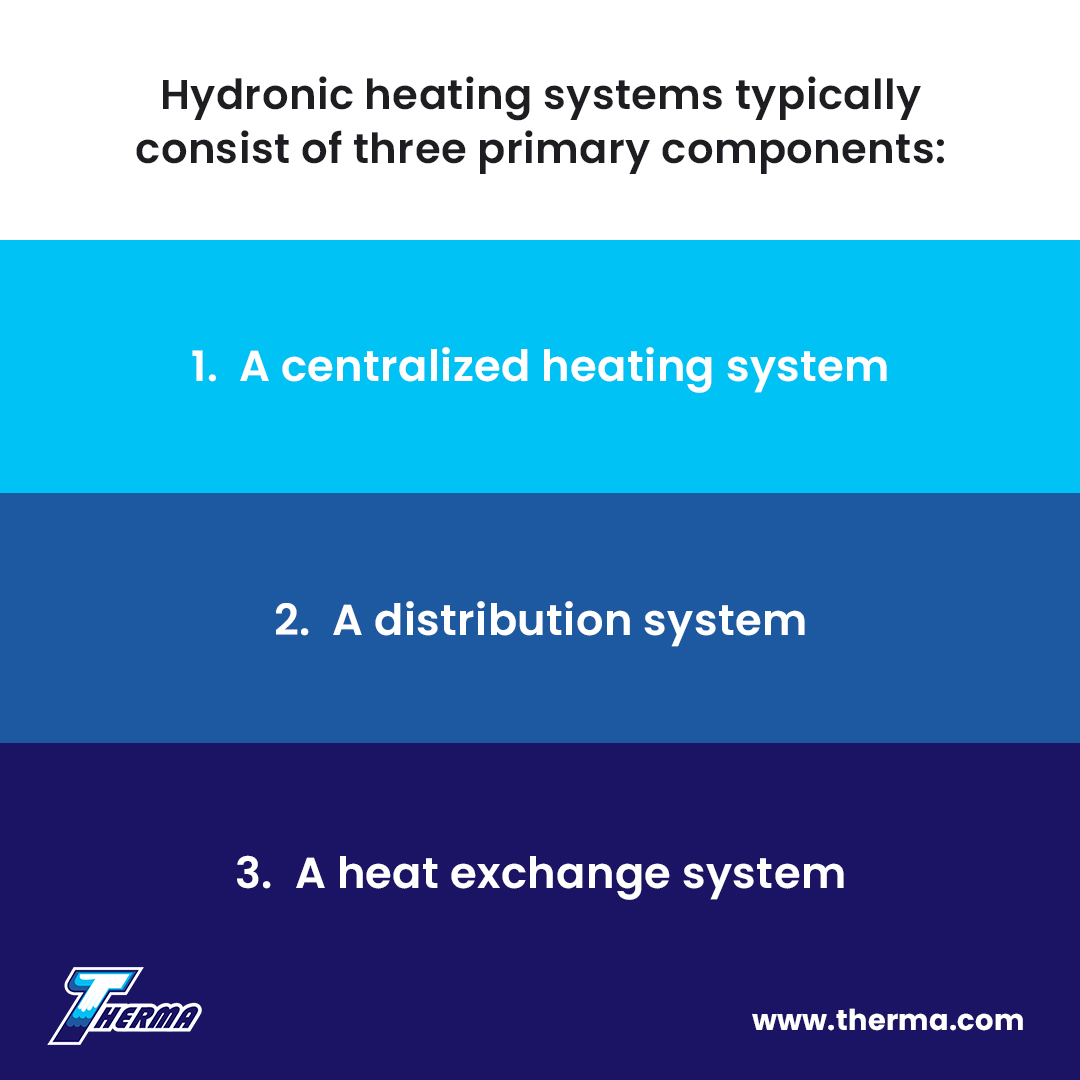Hydronic heating systems refer to systems in which space heating is achieved by circulating a hot fluid to radiant heaters. These systems offer an efficient and effective alternative to forced air heating systems.
Basic Operation

Hydronic heating systems typically consist of three primary components: a centralized heating system, a distribution system and a heat exchange system. Various options for each of these subsystems exist.
In the centralized heating system a heat source is used to heat the working fluid (often water) which is then pumped, via the distribution system, to the heat exchange system and back to the heating system in a closed loop.
Hydronic systems differ from forced air systems in that they heat a circulating fluid which in turn heats the ambient air in the building or room. In forced air systems, air is heated directly and mixed with ambient air in the building to achieve the desired temperature.

Heating system
Various options exist for heating the working fluid. Many systems use natural gas or oil fueled boilers while geothermal heat pumps can be used in areas with good geothermal resources. Wood or other solid fuel furnaces can be used, as can solar thermal energy. The choice of heat source depends on preference and practicality (local resource availability etc) and should be considered carefully as it impacts the overall efficiency of the system. The use of modern high efficiency heating systems is one of the major strengths of hydronic systems although forced air systems are increasingly benefitting from improved heating efficiency as well.
Distribution system
The distribution system is responsible for transporting the hot working fluid from the heating system, to the heat exchangers, and back to the heating system. This system typically consists of a thermostat, a pump (or pumps), piping and valves. The closed loop nature of hydronic systems contributes to their efficiency since unused heat is retained in the system resulting in reduced energy input requirements.
The small pipes used in hydronic systems are easy to insulate effectively and so thermal losses in the distribution system are limited. The larger air ducts used in forced air systems are more prone to thermal losses and as a result more energy is required for heating.
In addition, hydronic systems circulate a relatively small amount of hot fluid whereas forced air systems have a relatively large air circulation requirement. The energy required to distribute the heat throughout the building is therefore typically less in hydronic systems.
Space heating
Hydronic systems make use of so called radiative space heating. The hot working fluid heats surfaces that are in contact with the ambient air in the building or room and heat is transferred to the space through a combination of thermal radiation and natural convection. Examples of radiant heaters include radiant floors and wall mounted radiators.
In radiant floors, a looping pipe network is installed directly into the room’s floor and heat is conducted from the hot pipe into the floor material causing the floor temperature to increase. The warm floor then heats the air inside the room. In externally mounted radiators heat is transferred directly from the hot pipes to the ambient air. Radiant heating capitalizes on the buoyancy of warm air to achieve uniform heating and reduce temperature stratification.
In contrast, forced air systems rely on mixing of the hot supply air with the cooler ambient air. The hot air is typically supplied through a vent into the room and as such heating is relatively localized and the distribution of heat through the space is less uniform. Users may therefore require more heating than necessary for the same level of comfort.
Efficiency: Hydronic vs Forced Air Systems
For heating systems efficiency can be defined as the ratio of useful heat output to the total energy input required to achieve the desired thermal control. Provided the system is well insulated, hydronic systems benefit from lower thermal losses and lower distribution energy requirements than forced air systems and are therefore typically more efficient at maintaining thermal comfort.

By Michael Owen, PhD
Michael is a mechanical engineer working in academia. His research encompasses various aspects of fluid dynamics and heat transfer with a strong emphasis on industrial heat exchangers.
Sources:
- https://physics.info/radiation/
- http://www.thermopedia.com/content/786/
- https://www.greenbuildingadvisor.com/article/cold-floors-and-warm-ceilings
- https://www.hvac.com/blog/what-are-forced-air-systems-here-are-3-things-you-should-know/
- http://renew.org.au/articles/all-electric-and-hydronic-a-model-of-efficiency/
- http://www.green-energy-efficient-homes.com/most-efficient-home-heating.html
- https://www.hydronicheating.net/







